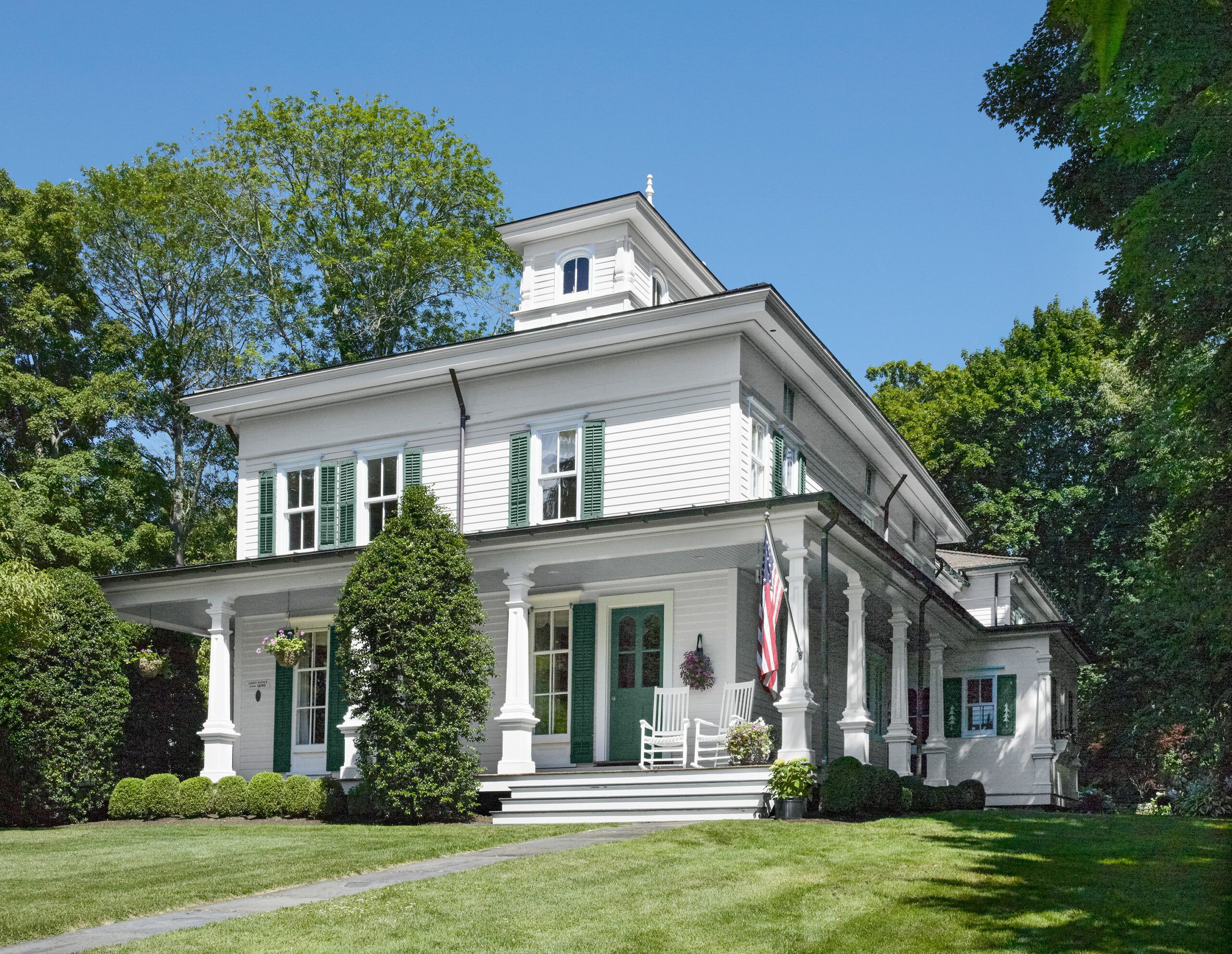Restored Italianate
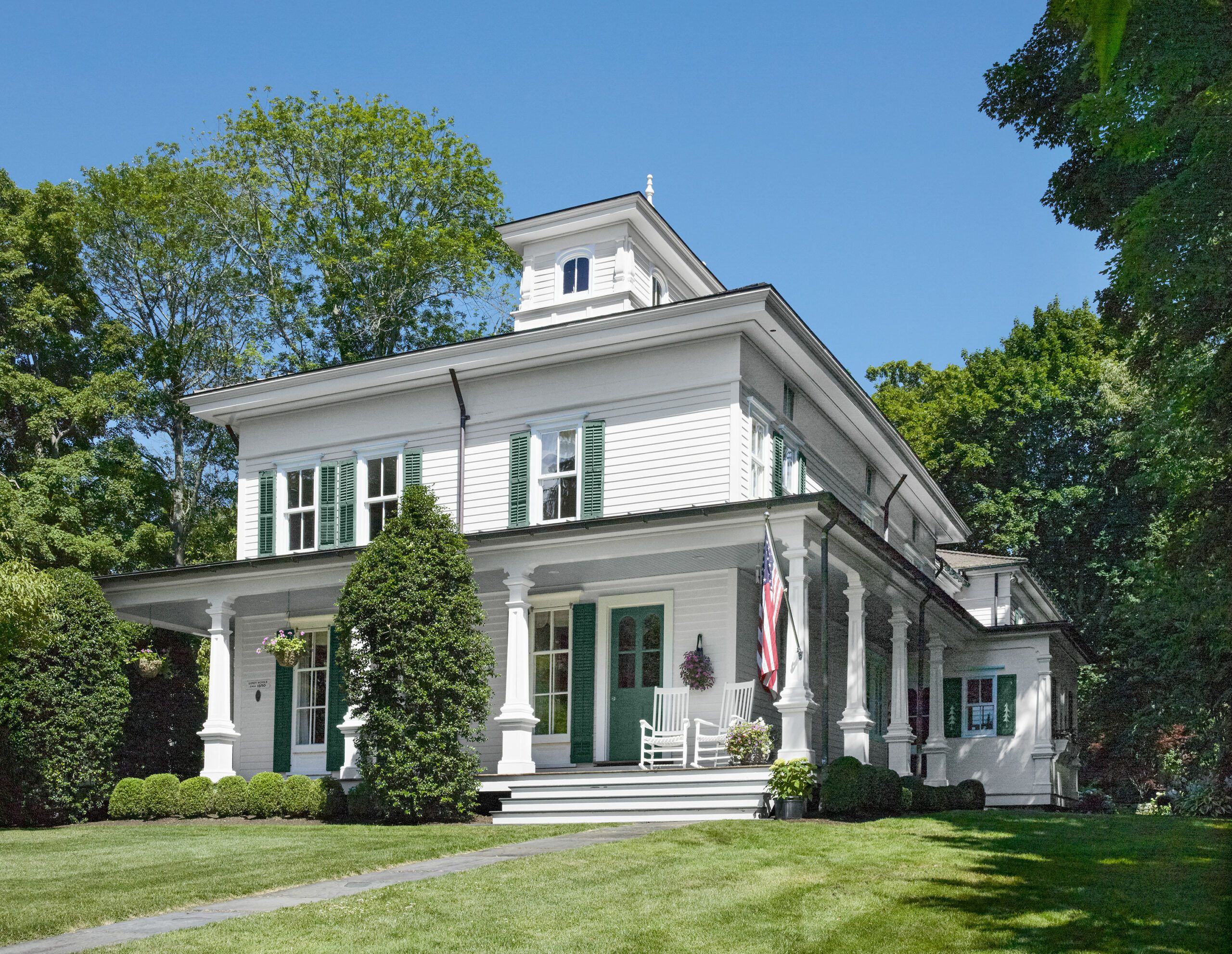
You might say that Jeff and Michele Williams’s house is living its third—and perhaps its best—life.
From the sidewalk, the stately white-clapboard home with the hipped roof and wraparound porch doesn’t look much different from the other antique houses that survive in the Nichols Farms Historic District in Trumbull, Connecticut. Its tall windows, post-on-pedestal columns, and rectangular cupola all confirm its identity as a mid-19th-century Italianate, the kind of fashionable home favored by merchants who profited from the town’s pre–Civil War carriage and saddle trade. The Trumbull Historical Society traces the circa-1860 home’s origins to Sidney Nichols, a descendant of the very first farmer who arrived in the area in the 1690s.
Shown: From the front, the restored home looks much as it might have circa 1860, with little hint of the rear addition. The house’s Italianate flourishes include the post-on-pedestal porch columns and the cupola with arched windows. The 7-foot wood finial atop the cupola roof can just be glimpsed here.
Post-On-Pedestal Porch
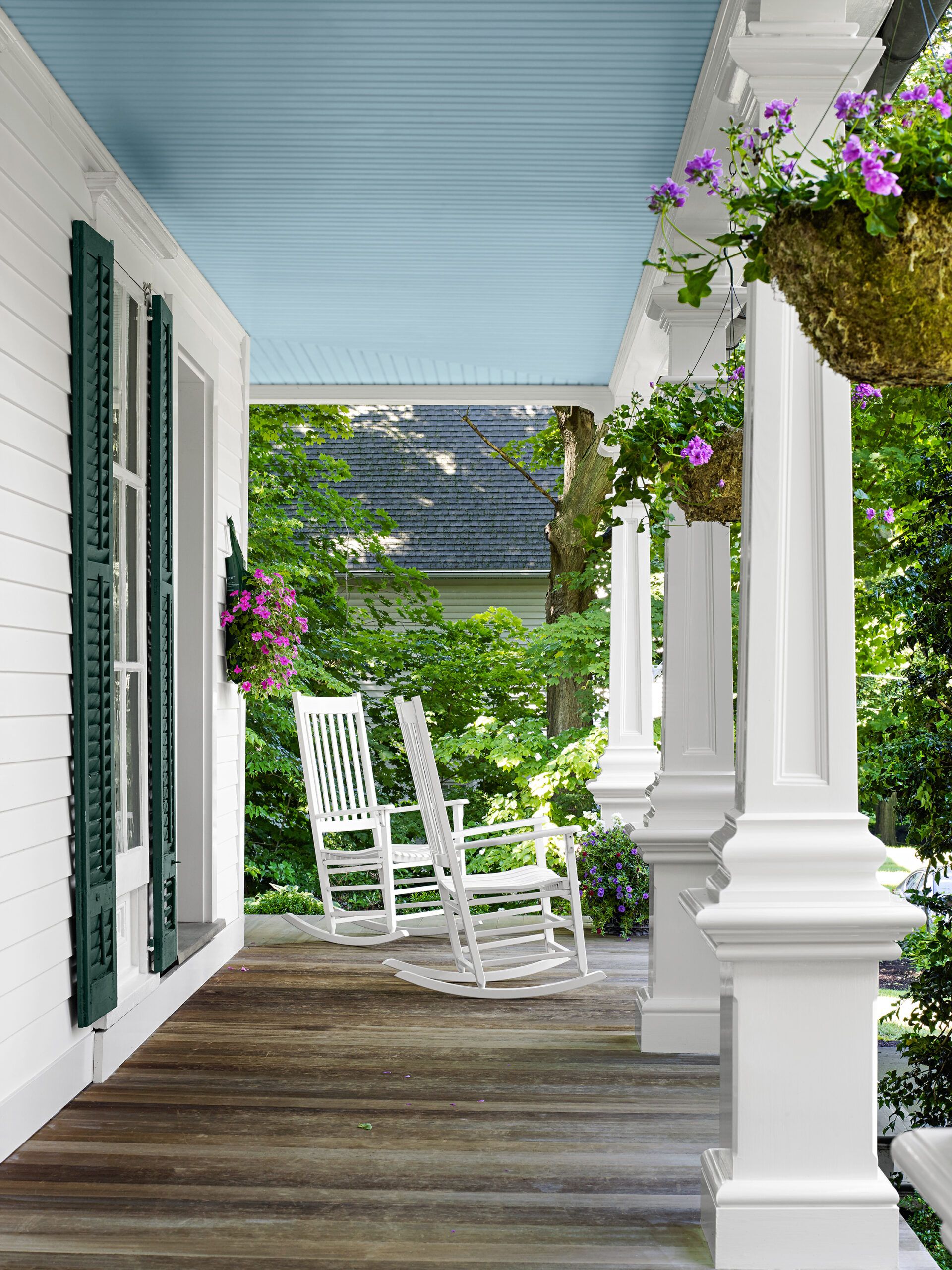
But there’s more to the story, as Jeff, a builder and cabinetmaker, found after buying the house in November 2001. As he stripped away old, rotted parts of the house, he discovered something: The home he had just bought wasn’t originally a hipped-roof Victorian-era building. In the attic, marks in the framing indicated the house had once had a gabled roof and a center chimney. “There were notches on two sides, and you could see where the rafters were pegged,” he says. Working with a local restoration architect, the late Robert Hatch, Jeff concluded his home was actually built around 1805 as a center-chimney Federal-style Colonial. His vintage home, it turned out, was more vintage than he’d thought.
Shown: Restoring the circa-1860 home’s beautiful post-on-pedestal porch columns was among Jeff’s most time-consuming projects.
Paint supplier: Huntington Paint & Wallpaper
Paint: White (siding and trim), Hunter Green (shutters), and Marlboro Blue(porch ceiling); Benjamin Moore
The Homeowners

Acknowledging his home’s true past, Jeff went to work bringing it into the present. He found the structural framing remarkably intact. “There wasn’t a rotten piece—everything was amazingly straight, even after 200 years,” he says. Still, the interior showed its age, so he dismantled, shored up, and rebuilt all the walls, floors, and ceilings, salvaging material for reuse as he went. Then he doubled the square footage with an addition so faithful in style that it’s nearly indistinguishable from the old portion. When the insurance company ultimately asked what year it was built, Jeff recalls with a grin, “I said, ‘The house was built in 2002.’ “
Shown: Homeowners Jeff and Michele Williams
Family Room Millwork
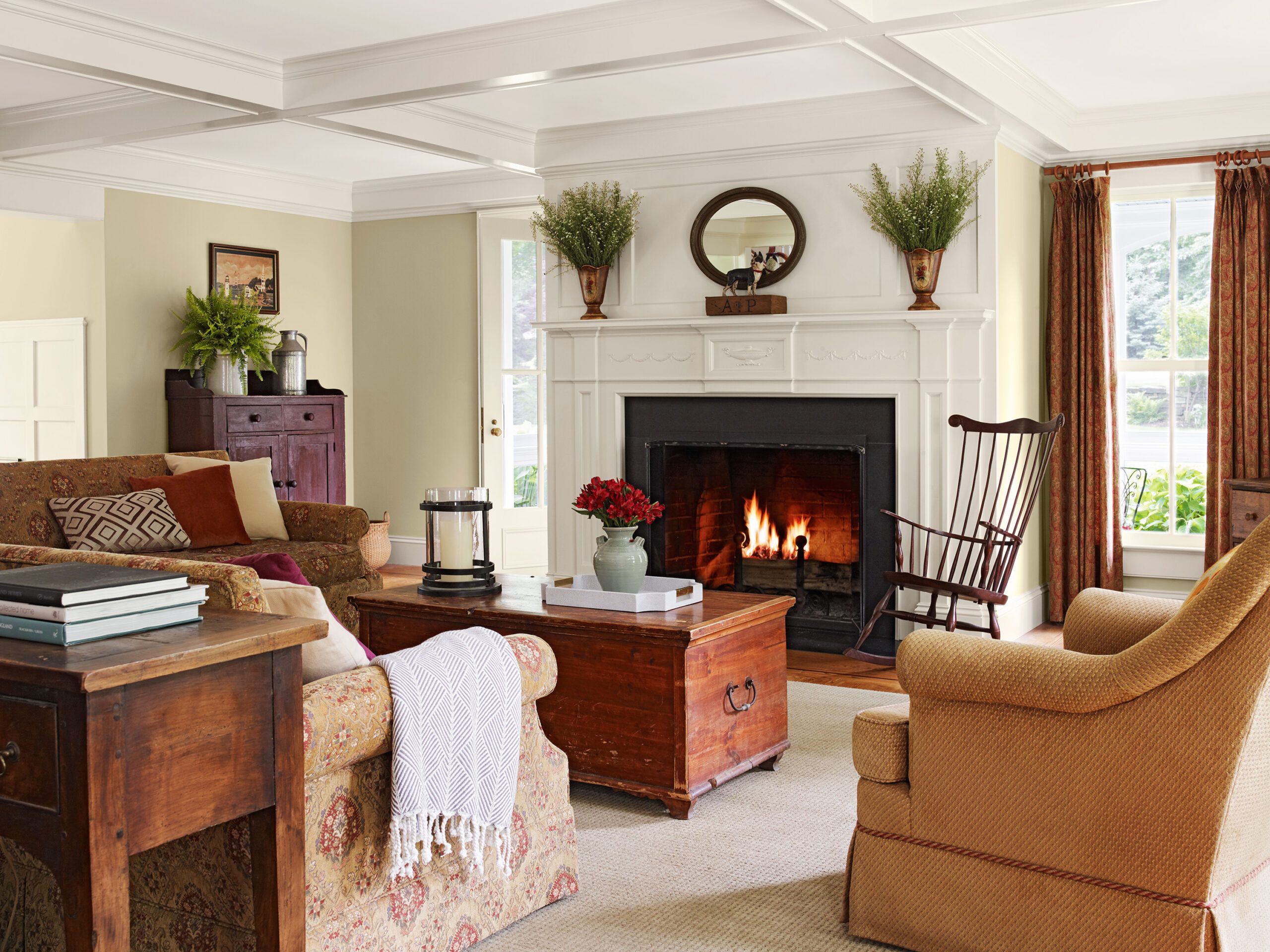
It was a house Jeff had long admired. Decades before he and Michele came to live there, it belonged to the family of one of Jeff’s high-school friends; he remembers well the pink wicker furniture the family set out on the porch each spring. Years later, after he had established himself as a contractor, the family called him to patch a hole in the porch roof. They said they were selling the home, and in fact already had a buyer.
Shown: Part of a 2002 addition, the family room displays homeowner Jeff Williams’s flair for period-style millwork.
Builder: Jeff Williams, JW Millwork
Paint: Richmond Gray (walls) and Navajo White (trim); Benjamin Moore
Breakfast Room
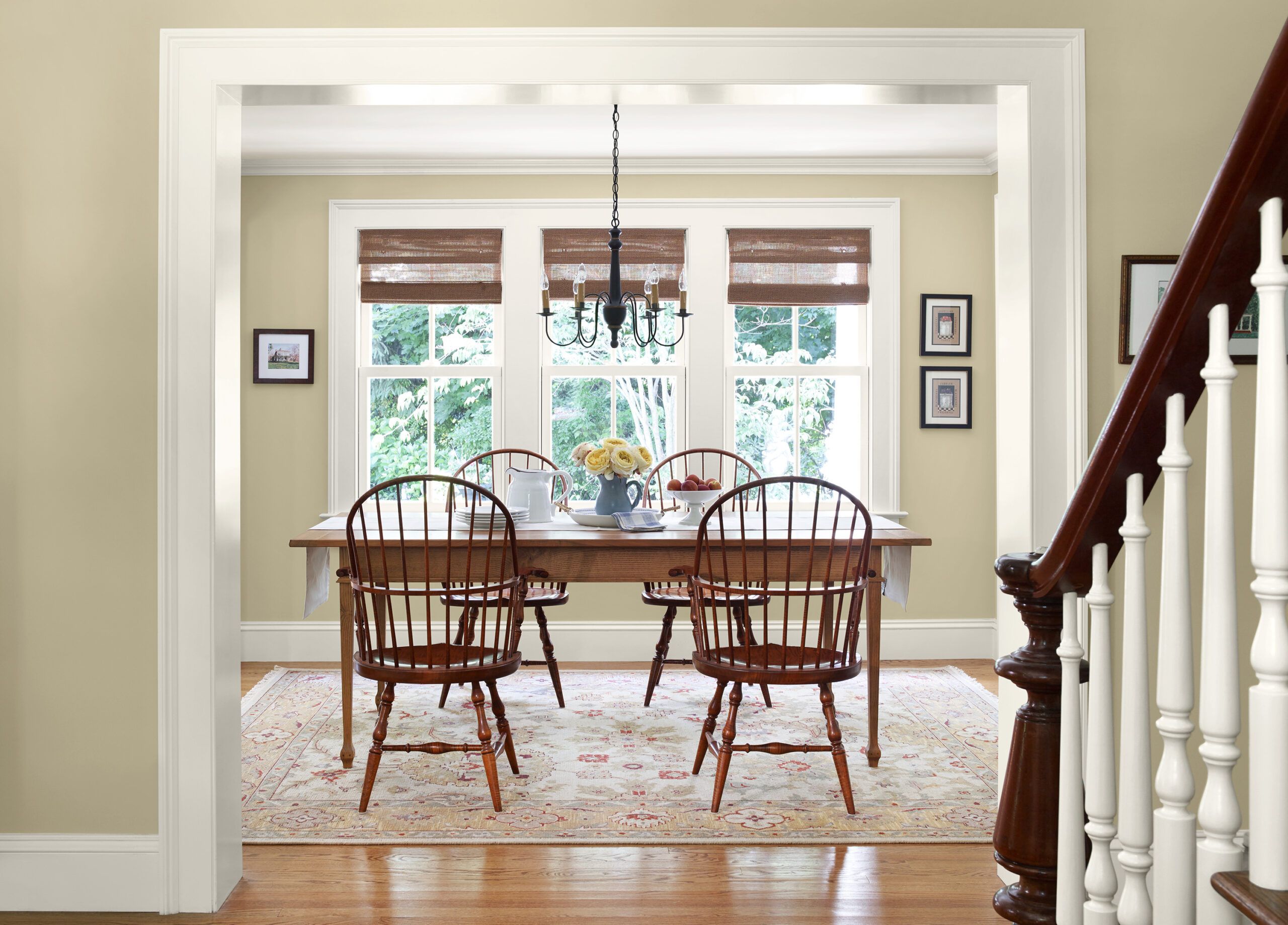
But within months, Jeff noticed that the pink furniture was back out on the porch. And then, in late 2001, his sister called to tell him she’d seen a FOR SALE sign on the lawn.
Jeff didn’t waste any time. “I went and knocked on the door,” he says. “I walked through, and in twenty minutes I made them an offer.”
Shown: Included in the addition, a breakfast room links the kitchen, in what was the original house, to the new family room. Jeff built the table, and he and wife Michele snatched up the vintage Windsor chairs that surround it from a local auction house.
Chairs: Black Rock Galleries
Light fixture: Valley Lighting & Home Decor
Enlarged Island
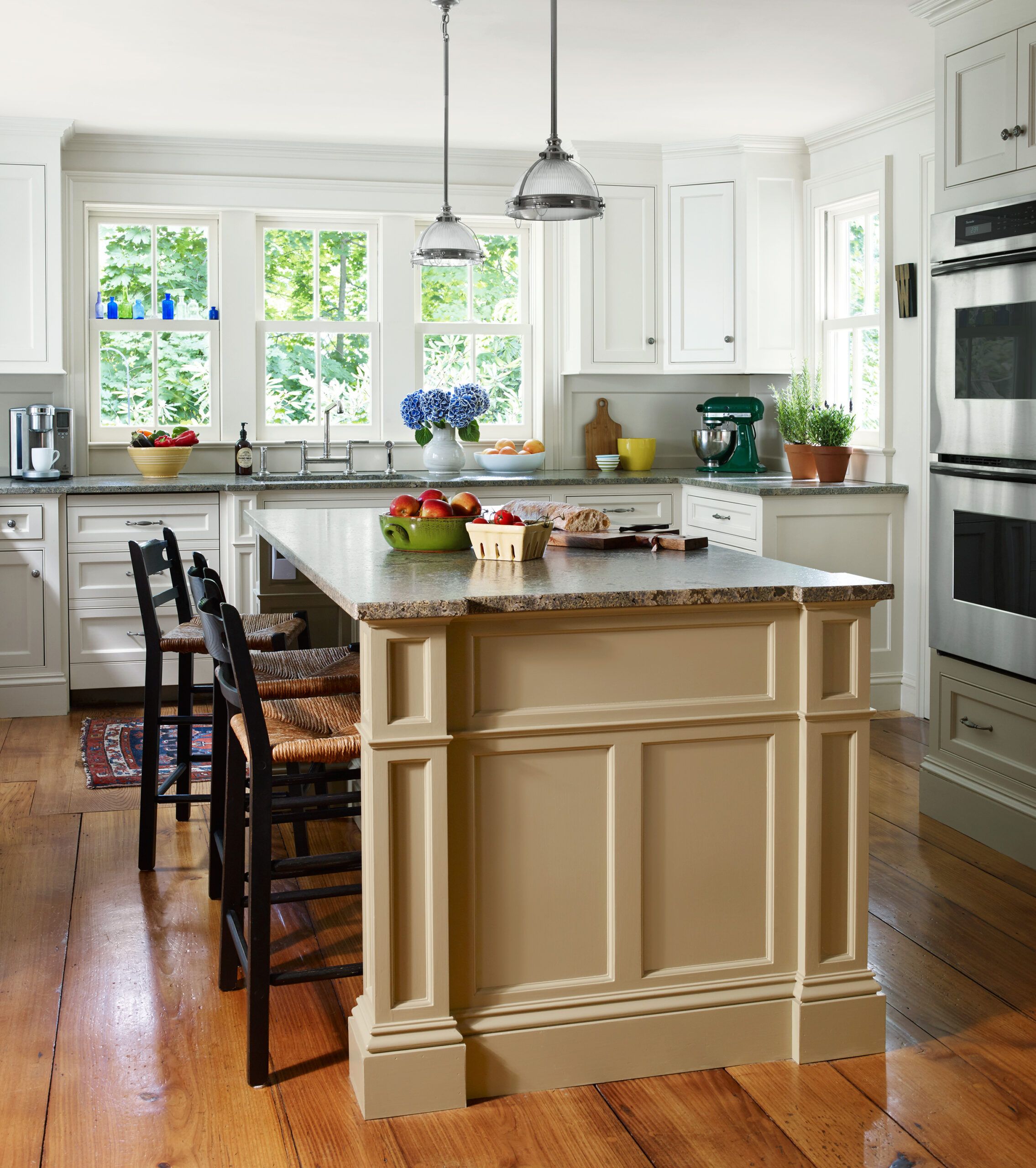
He went to work on the house just as the New England winter swept in. By now an experienced builder with his own cabinet shop, Jeff took on much of the project himself, working from breakfast till dinner and flopping at his sister’s home nearby. He stripped out the old lath-and-horsehair plaster walls, rebuilt the interior framing, and laid new floors. He installed insulation and sheathing—the old house had none—and replaced existing clapboards with new cedar. He removed and reglazed the original window sashes, using glass he salvaged from old windows he had collected. “I took a year off work and pretty much worked every day on it, and just kept going until I was finished,” he says. What he couldn’t handle—he draws the line at plumbing and electrical—he hired out to tradespeople he knew. With Hatch, he designed and built a rear extension that holds a second stairway, breakfast and family rooms on the first floor, and a master suite on the second. With details borrowed from the older parts of the house and slightly smaller in scale, the addition looks as if it has always been there.
Shown: In 2012, the couple remodeled the kitchen a second time, bumping it out to gain a view of the backyard. They replaced glossy granite countertops with leathered granite and installed a heating element beneath the enlarged island’s top. Displayed on the window sash are colorful bottles Jeff unearthed during excavation for a barn he built on the property.
Paint: Great Barrington Green (island); Benjamin Moore
Pendant lights: Restoration Hardware
Stools: Monique Shay Antiques & Designs
Dining Room Murals
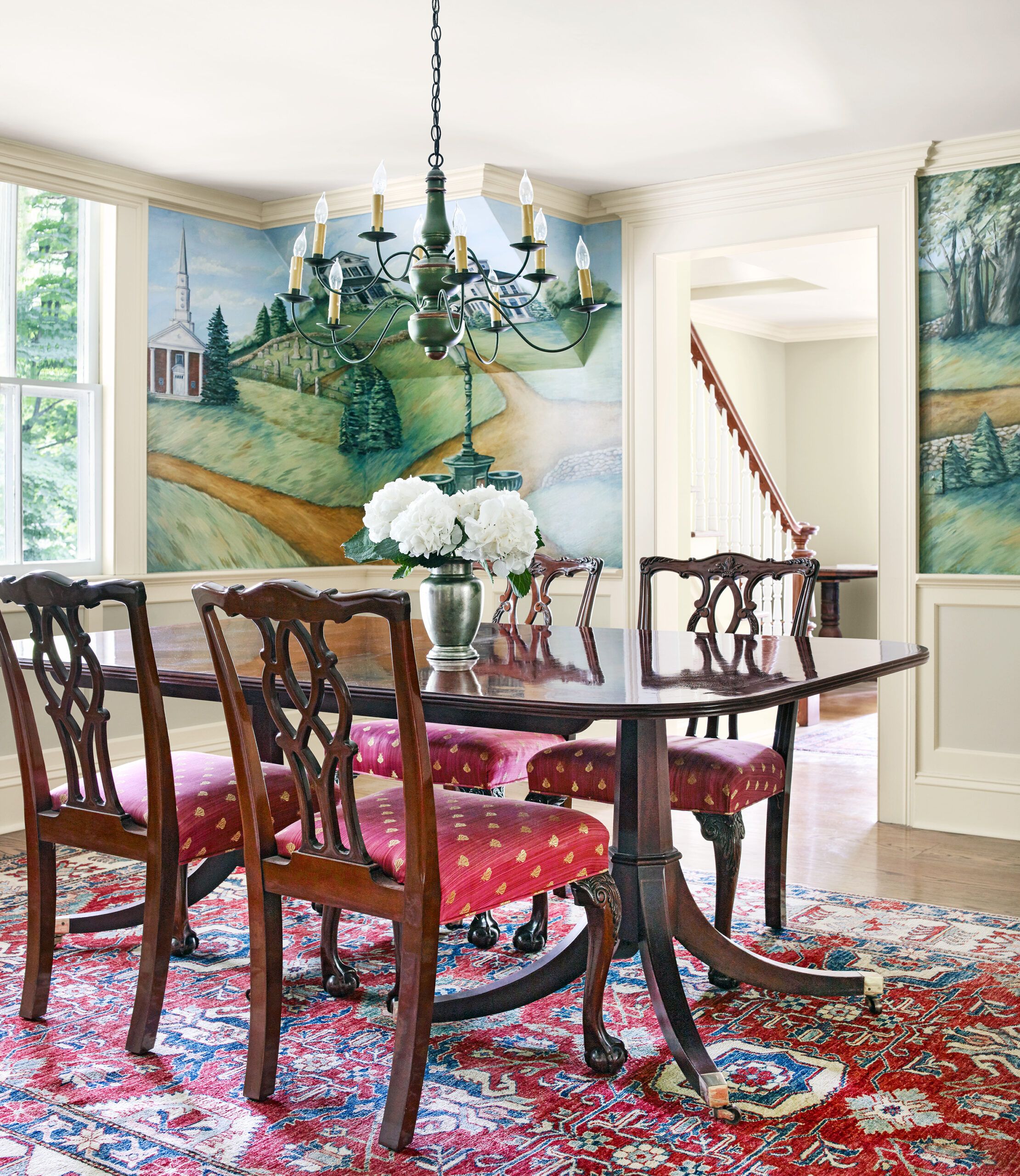
Jeff used interior details to blend the two sections together as well. “I always liked the finish work in construction,” he says. As a builder, he has distinguished himself from competitors with well-crafted details—built-ins, coffered ceilings, and lots of trim. “I put crown molding in the closets,” he says.
Despite its elegant exterior, the home’s existing interior had been uninspired. “The trim was all original, but it wasn’t detailed,” Jeff says. So he added flourishes of his own, many inspired by the luxurious interiors of homes he’d worked on along Connecticut’s wealthy “Gold Coast” towns. He capped his living room windows with decorative pelmets like those he saw in one house, and modeled a new living room mantelpiece after one in another. “I took a picture, and a few weeks later I had it up,” he says. To faithfully restore the house’s exterior, he had to order custom molding knives so that he could shape replacement parts for the porch’s paneled post-on-pedestal columns. He worked on the 7-foot pine finial that peeks out from atop the cupola by hand. “I’ve labored for hours on stuff people wouldn’t even think of,” he admits.
Shown: The rebuilt dining room is adorned with hand-painted murals depicting the Williams house amid other historic structures in the Nichols Farms Historic District.
Rug: HomeGoods
Claw-Foot Tub
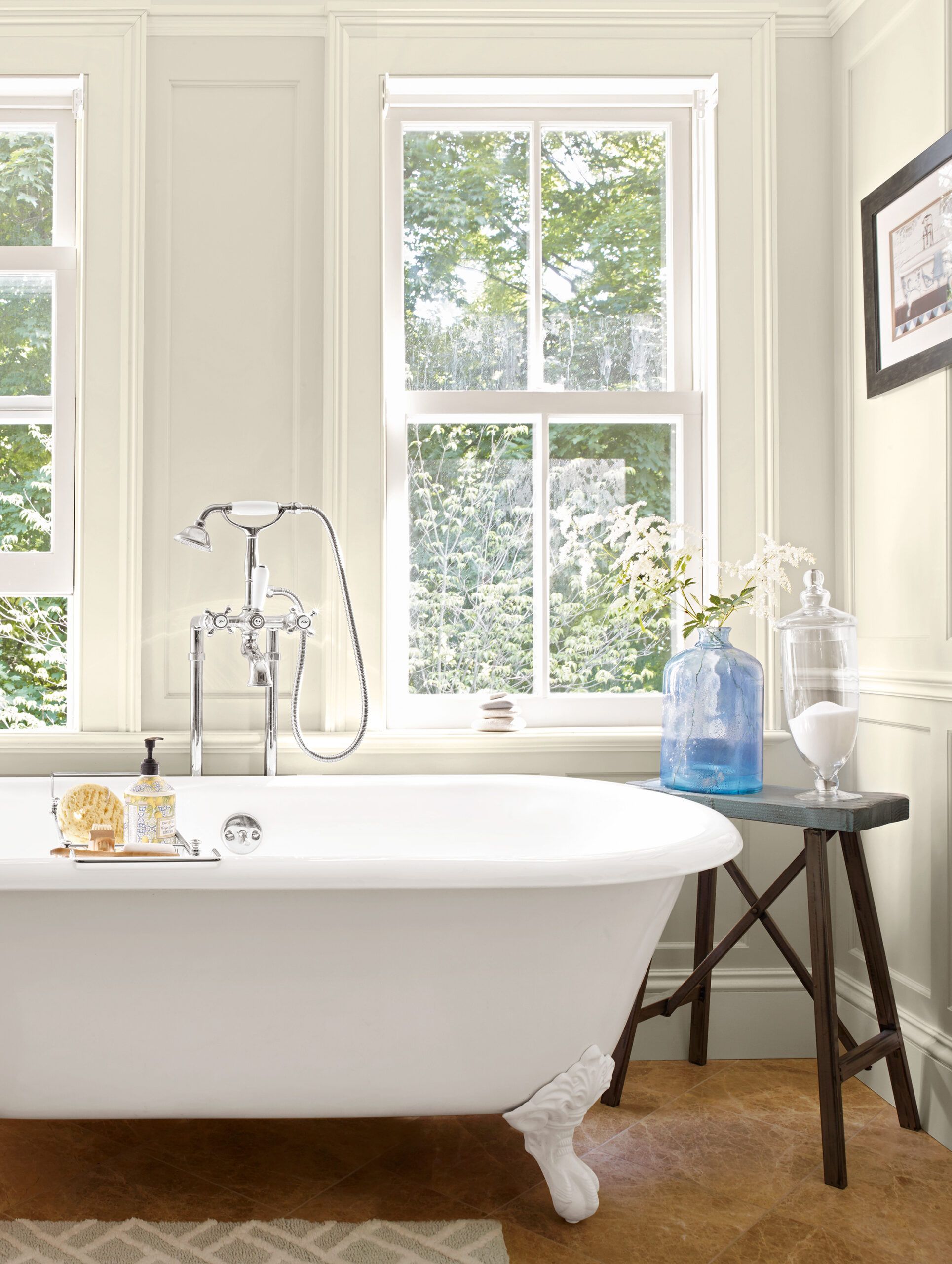
Jeff, meanwhile, hasn’t put down his hammer. In 2008, he added a three-season porch, building the walls in his shop and assembling it on-site. He added a barn with an in-law apartment, on the property where a derelict pond had been, and then turned his attention to the yard, building stone walls, laying a slate patio, and constructing a huge fieldstone fireplace. “A couple of years ago I got bored and built a greenhouse,” he says. “I like to stay busy.”
Shown: A reproduction claw-foot tub and floor-mount tub filler look right at home in the light-filled master bath.
Paint: Navajo White (walls and trim) Benjamin Moore
Master Bedroom Details
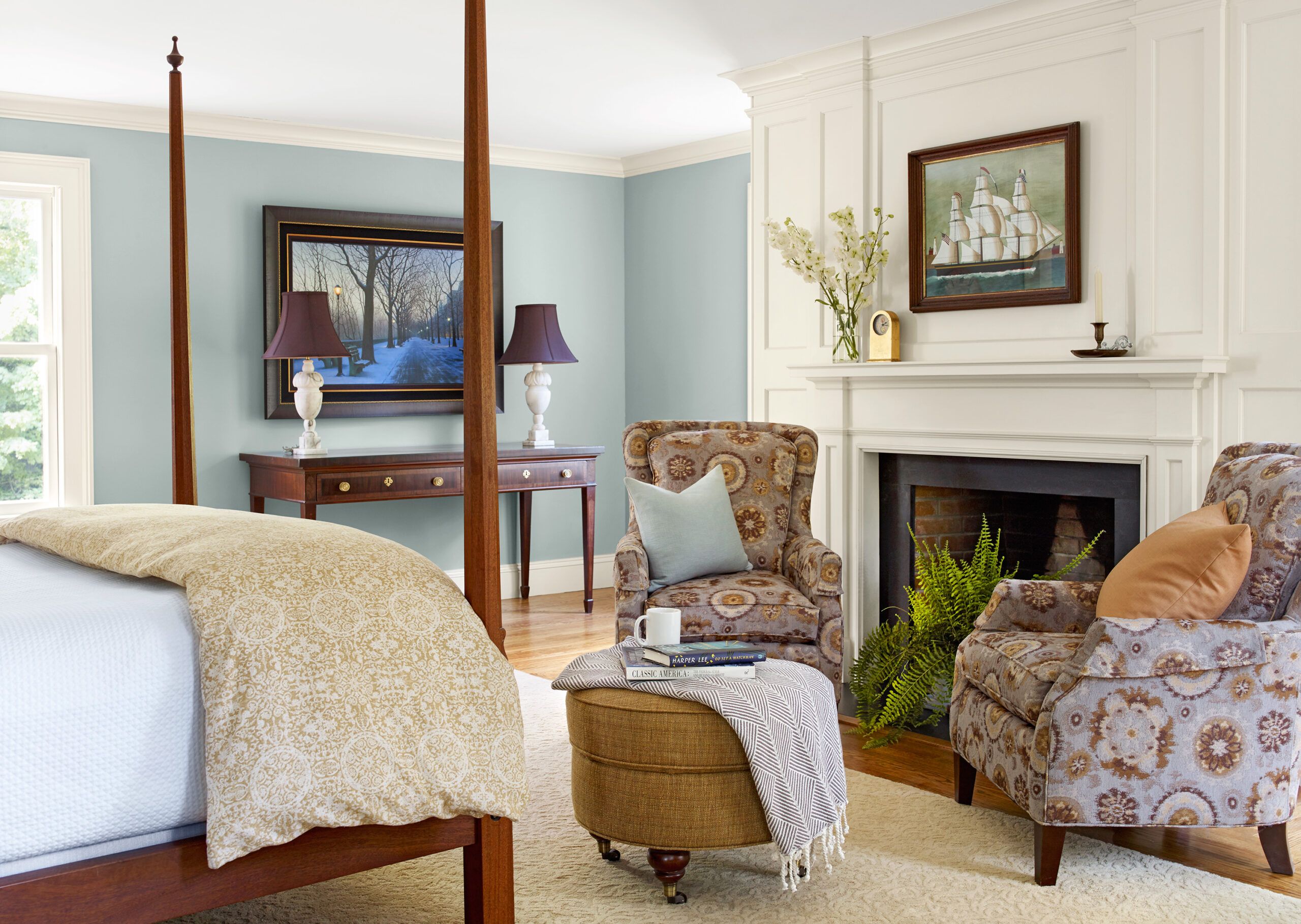
In 2012, they remodeled the kitchen, bumping it out several feet and adding a bank of windows for a view of the lushly landscaped backyard. The space balances up-to-date amenities with wide-plank floors and a large storage hutch, both built from antique chestnut boards found in the attic. Jeff used the same wood—marked by wormholes and stained by centuries-old nails—to top off a nearby wet bar. In expanding the kitchen, Jeff lengthened the island by 2 feet and replaced the polished granite he had originally installed with seafoam-green granite given a soft, leathered finish. Beneath the stone, he installed an electric radiant-heat mat, making the island a favorite place to linger over coffee on chilly mornings, and a natural location to set up the buffet for the couple’s legendary Christmas parties.
Shown: Upstairs in the 2002 rear addition sits the master bedroom, which showcases trim details similar to those Jeff added to the older part of the house.
Paint: Buxton Blue (walls); Benjamin Moore
Ringed with Window Seating
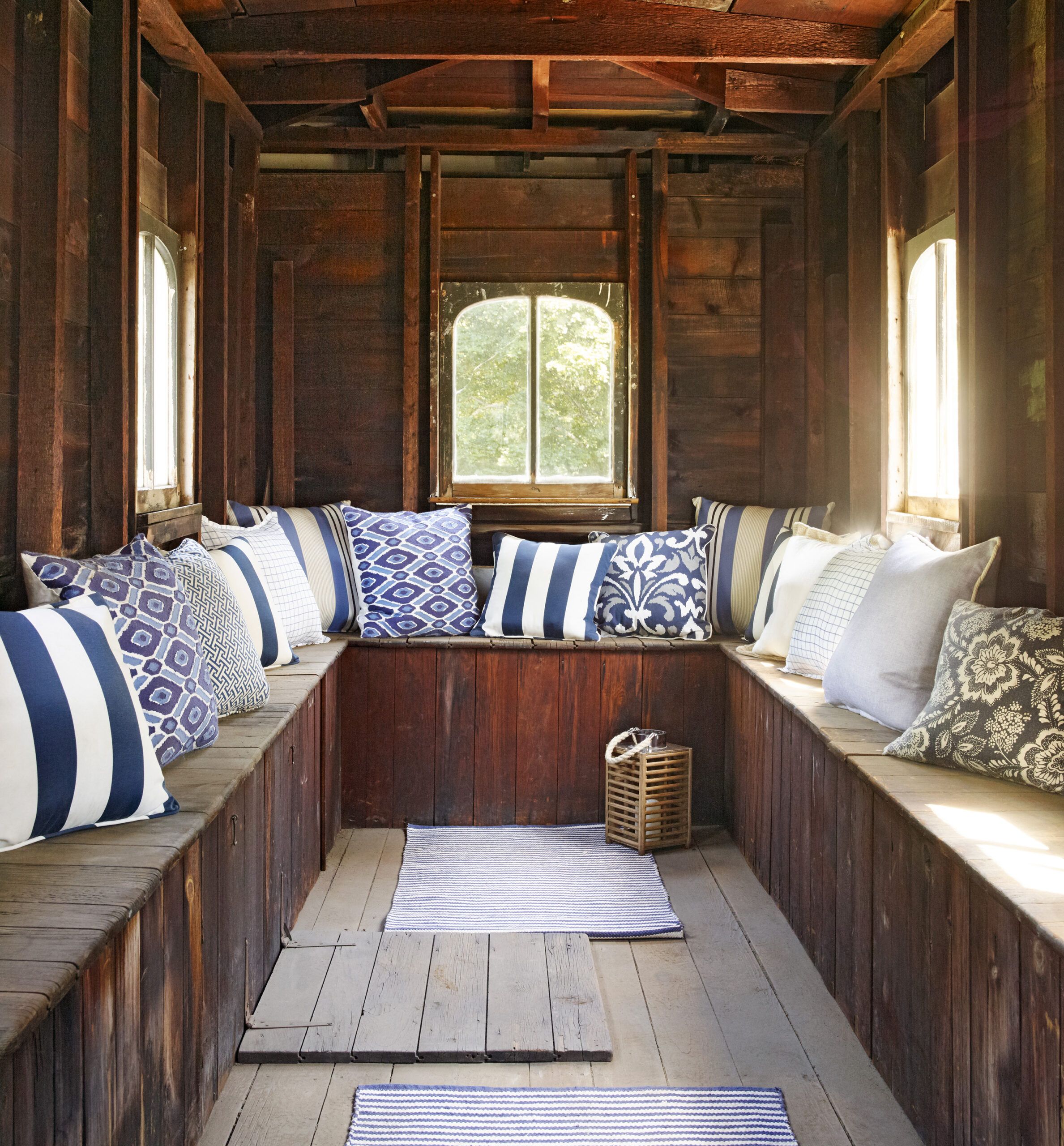
Such time-consuming details—the heated island, the faraway finial, the replicated porch posts—are all worth it to Jeff. “I did things that were overkill, but I’m thinking that this is my last stop,” he says, reflecting on the 21st-century legacy he has created.
Michele is in full agreement. “I love this house,” she says. “And when the day comes that someone else has it, I hope that they love this house like we do. It’s a special place.”
Shown: Accessed through a door in its floor and ringed with arched windows and bench seating, the interior of the cupola remains largely unchanged after more than 150 years.
Fireplace Outdoors
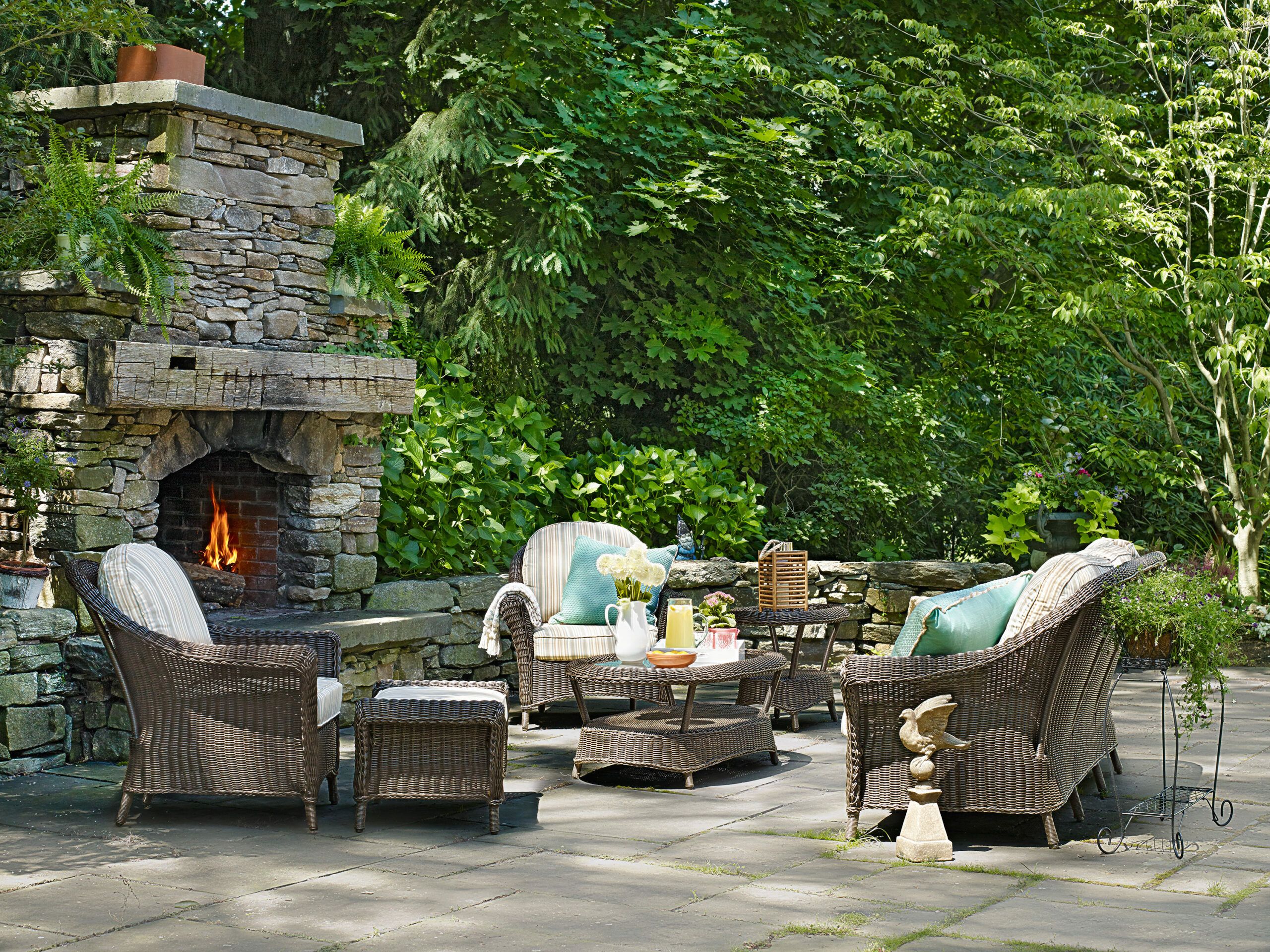
After restoring the house, Jeff improved the yard bit by bit, clearing brush and using stones scattered about the property to build features such as this fireplace. The mantelpiece is a weathered oak timber from another house.
Shown: After restoring the house, Jeff improved the yard bit by bit, clearing brush and using stones scattered about the property to build features such as this fireplace. The mantelpiece is a weathered oak timber from another house.
Patio furniture: Thos. Baker
Garden-View Addition
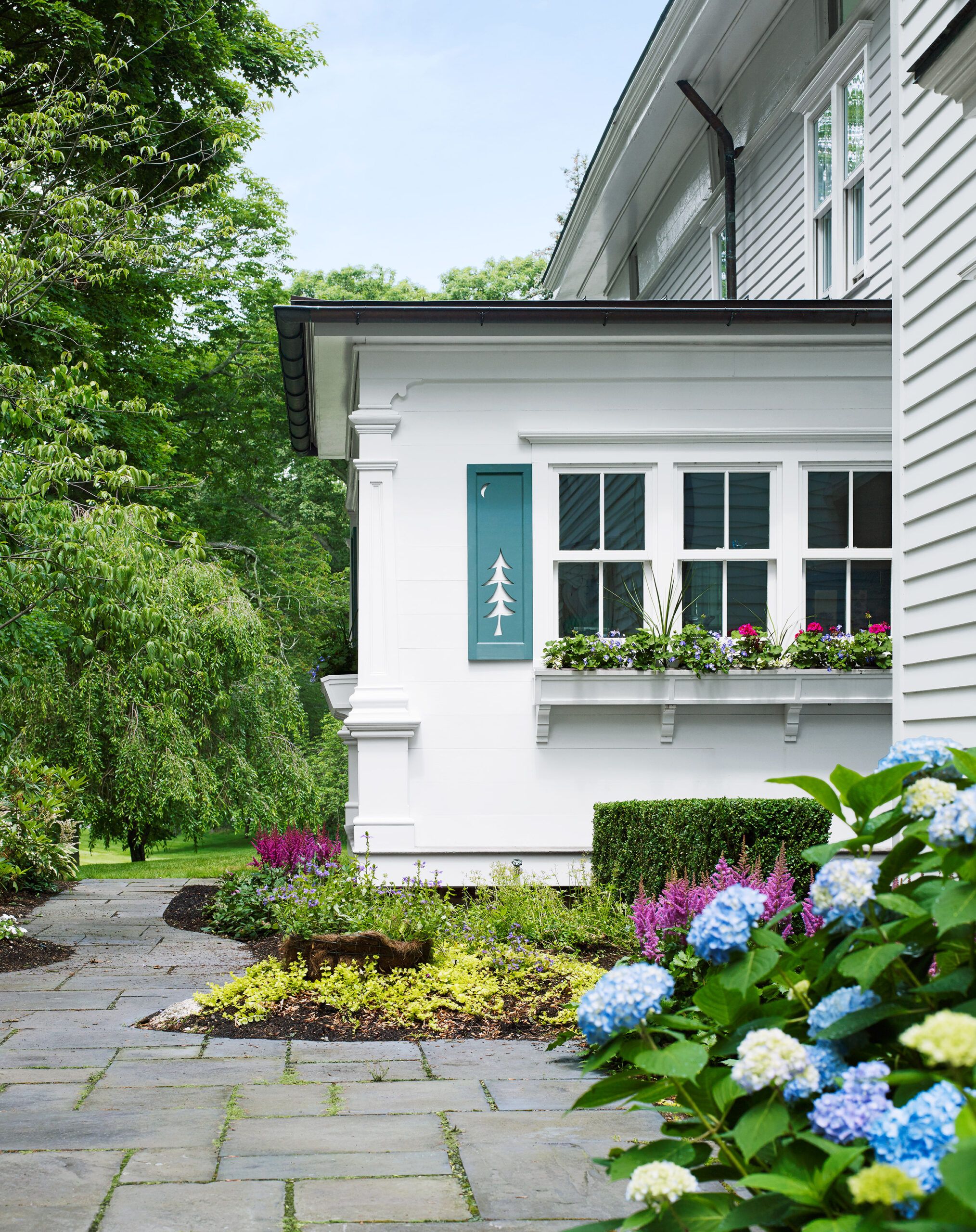
Jeff bumped out the kitchen in 2012 for a better view of the garden. The pierced shutters are his own handiwork; a future project, he says, is to create a second set with tulip cutouts for summer.
Screened Porch
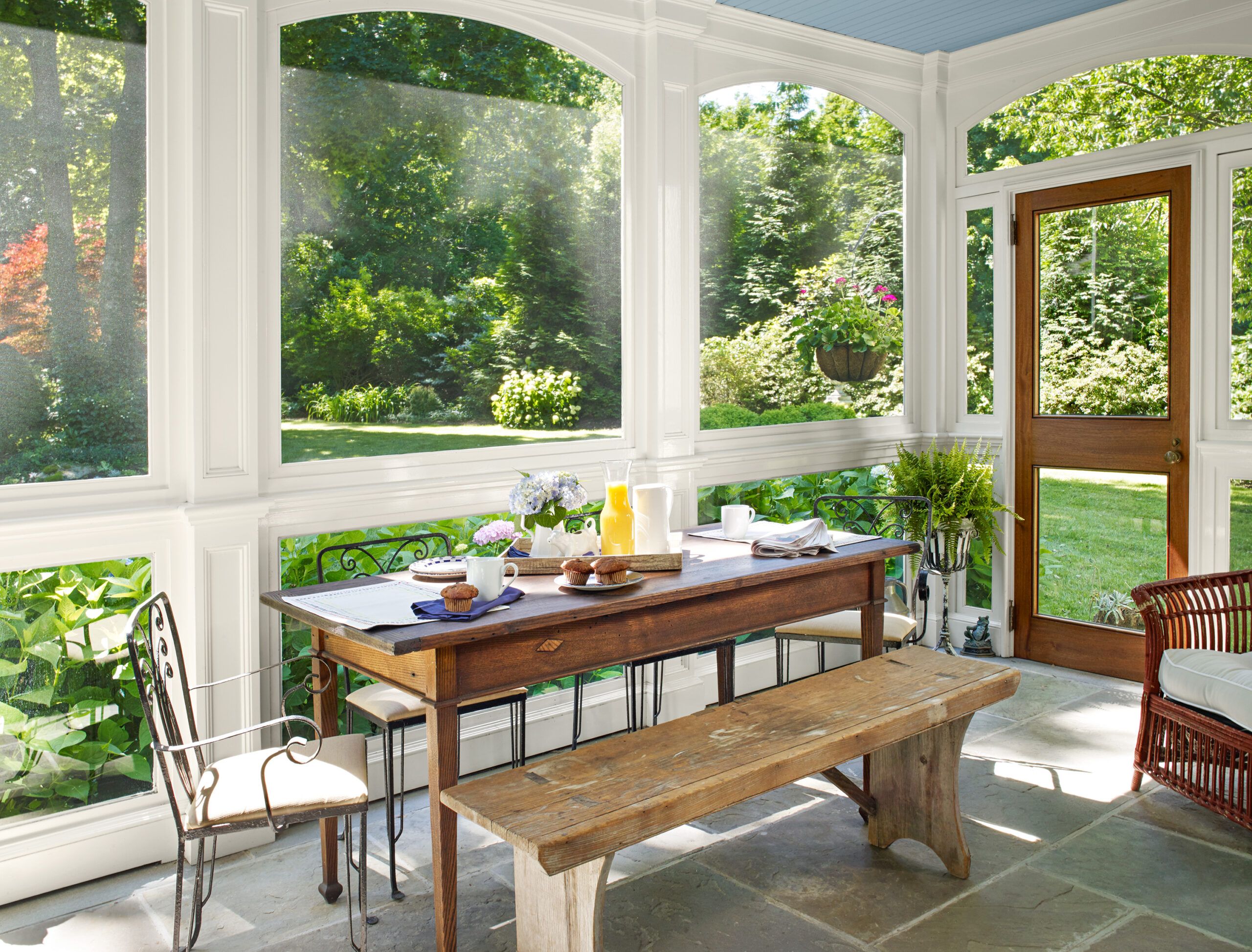
Jeff built the walls of the screened porch in his shop, then assembled it on-site. The paneled pilasters and arch details repeat Italianate features on the original house.
Lush Landscape
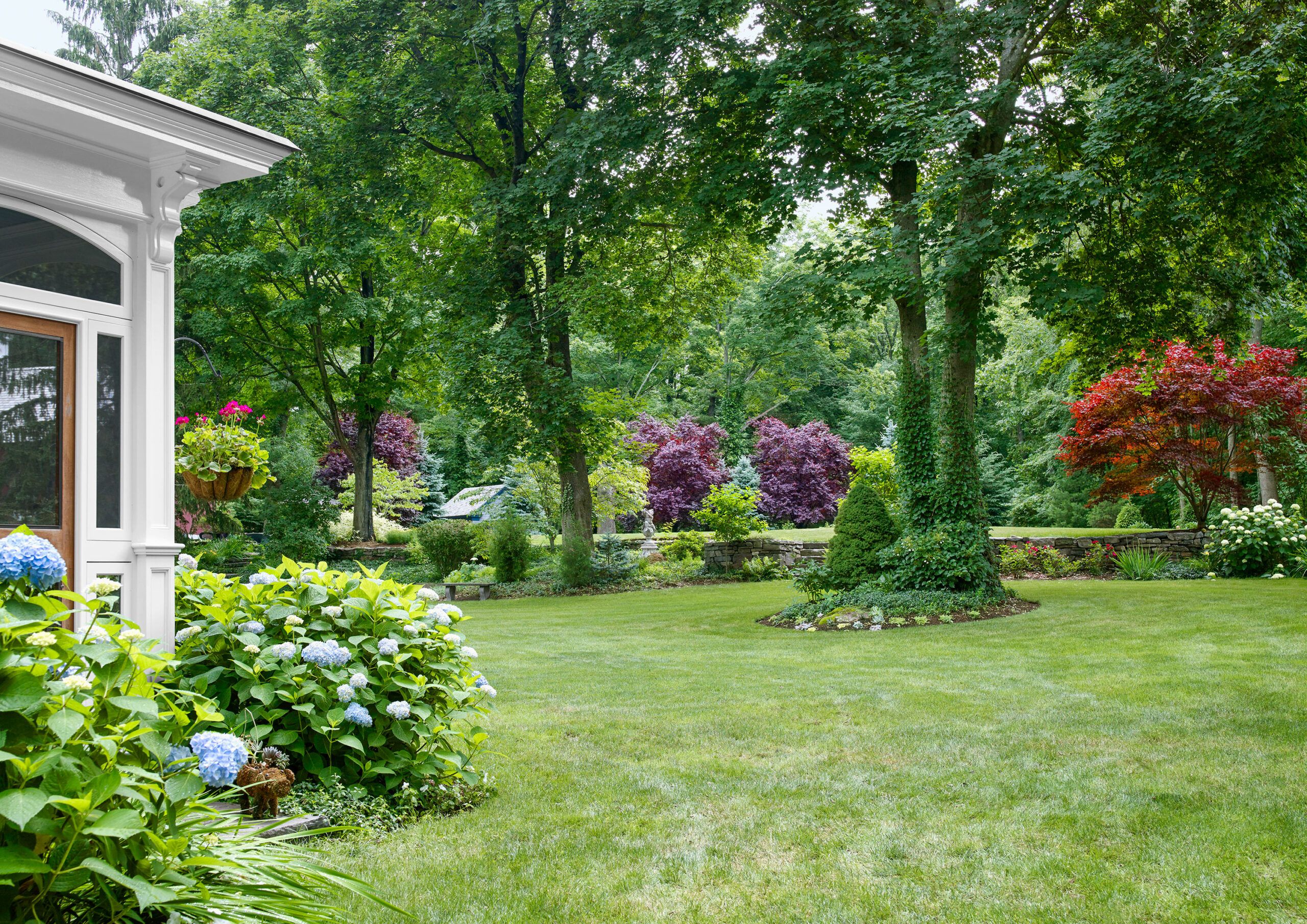
Ringed by blooming hydrangeas, the new porch “looks like it’s been there forever,” Jeff says. He has put his touch on the backyard, too, building the stone walls by hand, as well as the greenhouse glimpsed in the distance.
Mosaic Backsplash
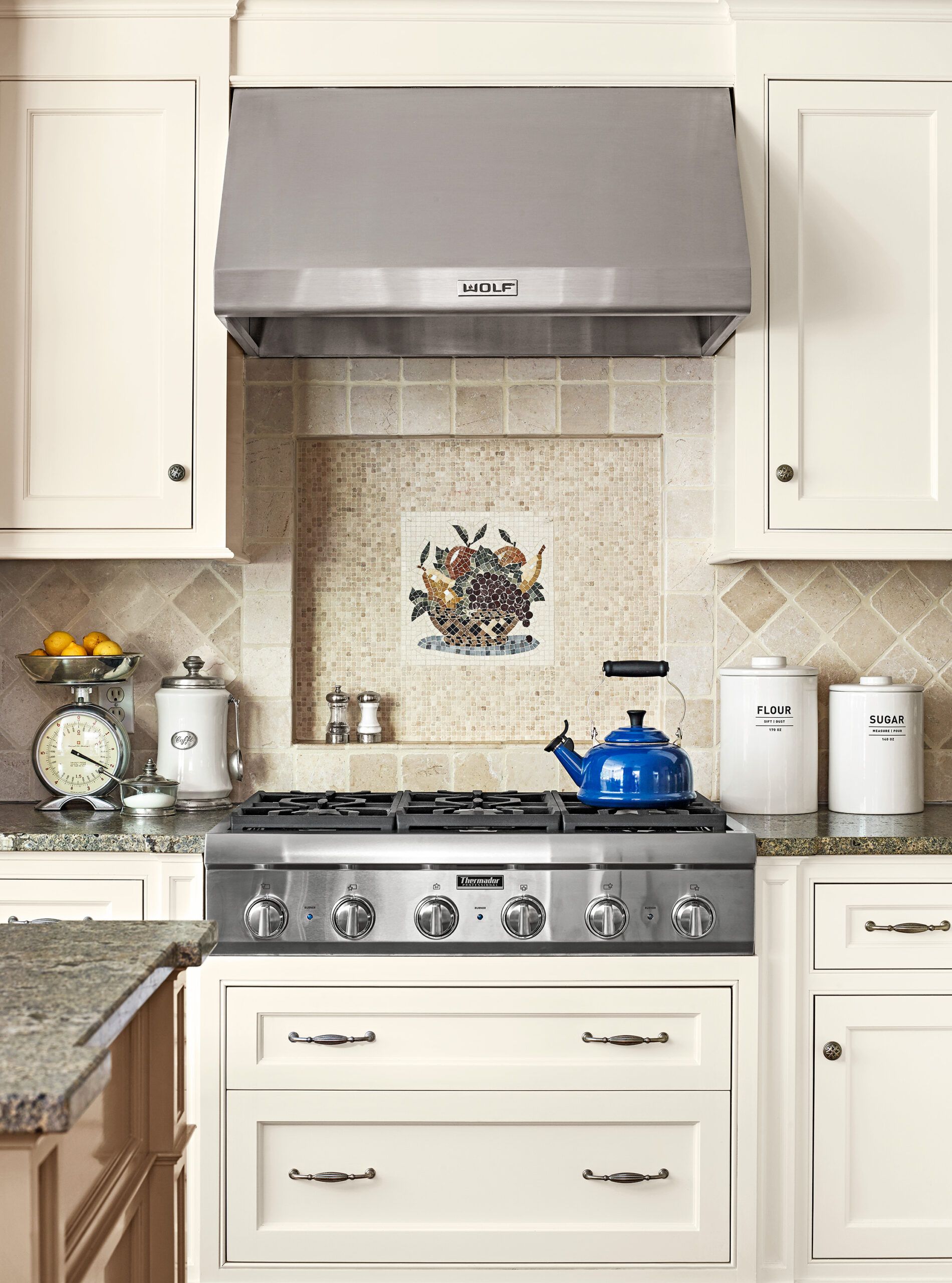
A Turkish tile mosaic adorns the backsplash inset behind the cooktop. A drawer just below it holds spices.
Wall ovens and cooktop: Thermador
Vent hood: Wolf
Pool Table

An alcove off the family room addition was specifically designed to accommodate a pool table. A slender walnut inlay on the floor shows where it is intended to be placed.
This Old Chestnut
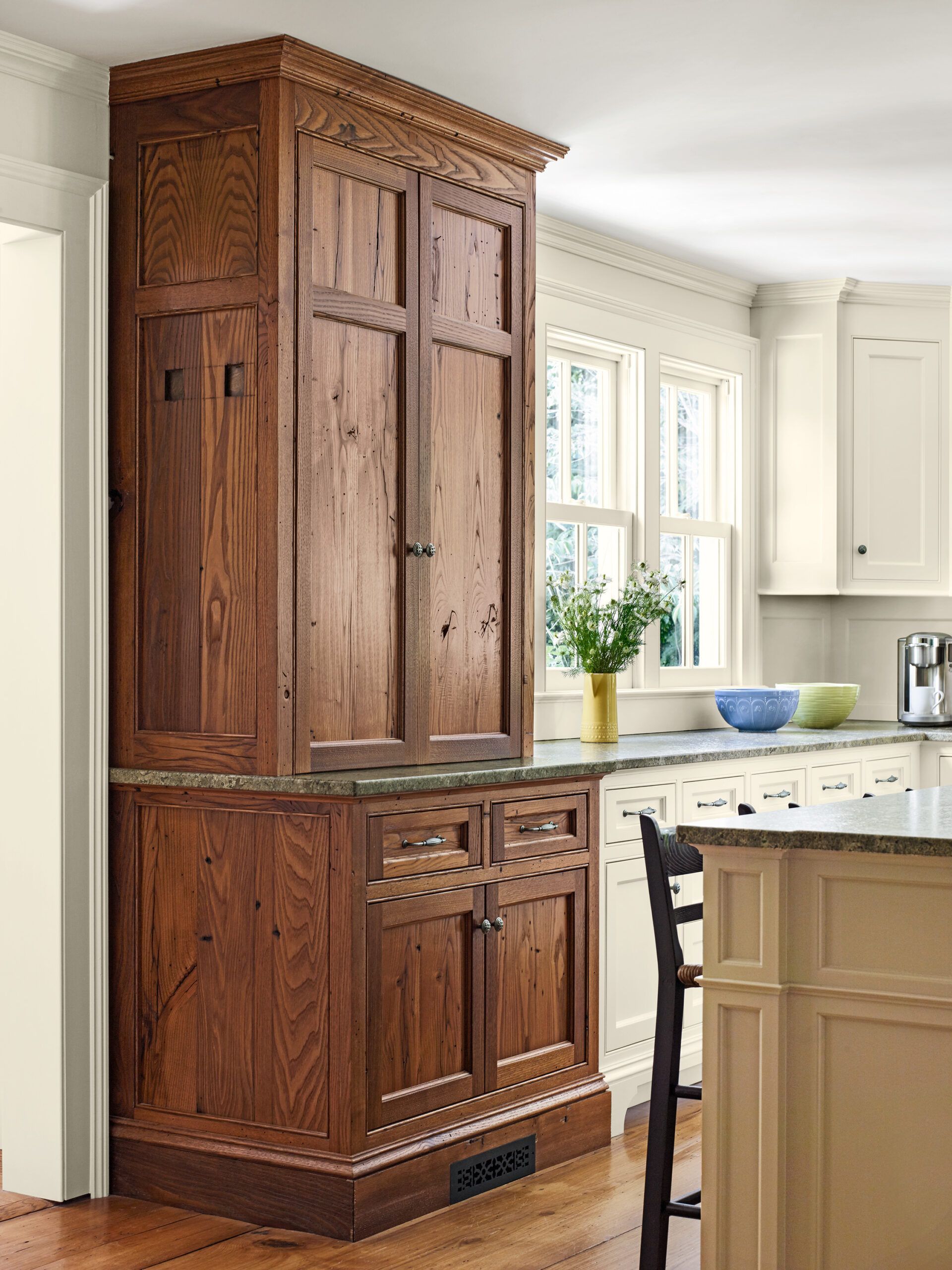
Jeff created this pantry cabinet using old chestnut framing lumber found in the attic. Wormholes and rust stains from old nails testify to its history.
Wet Bar Custom Cabinetry
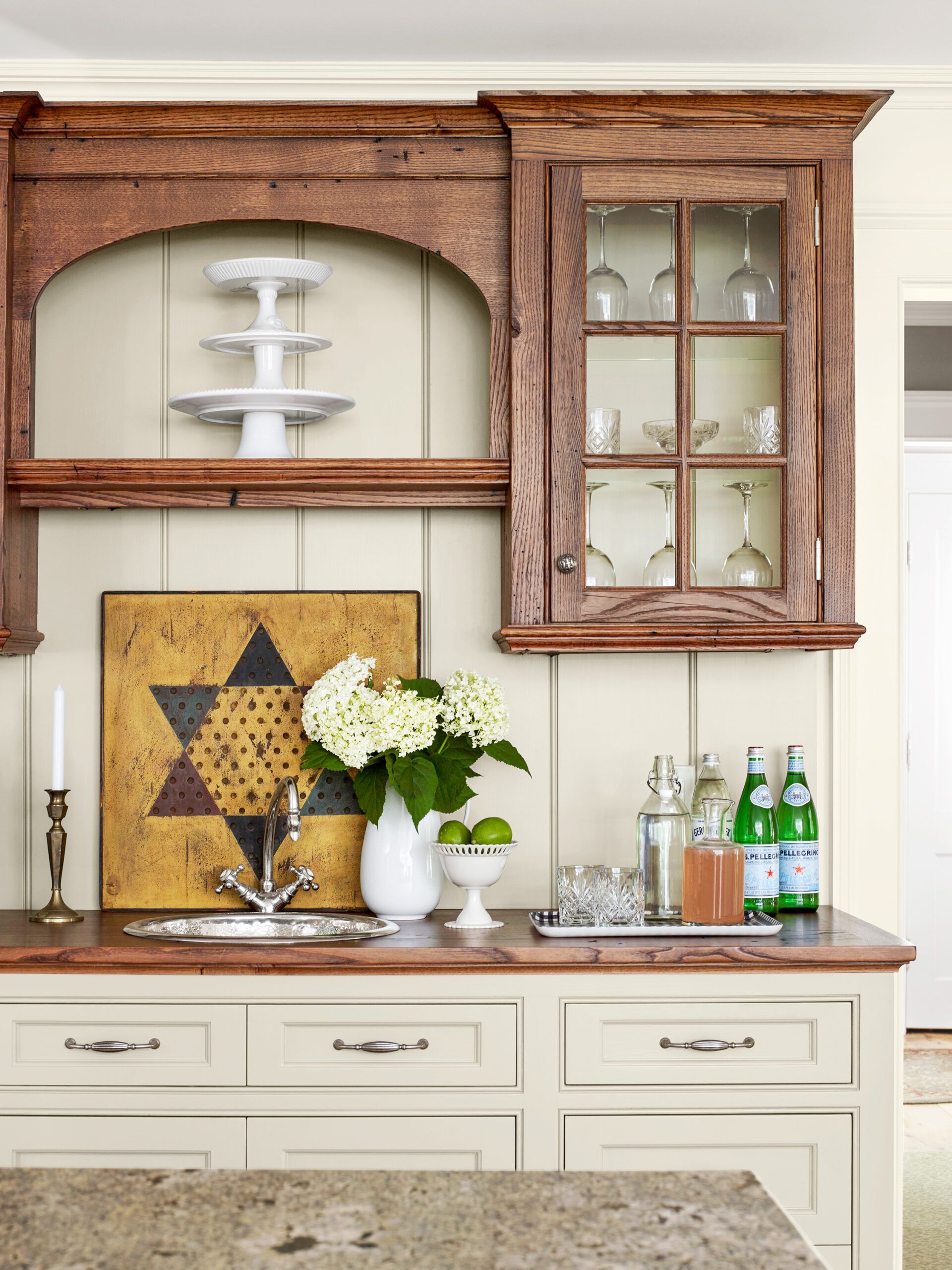
Jeff built all the cabinetry for the house, including the wet bar in the kitchen. He used salvaged glass for one pair of doors and chestnut lumber found in the attic for the upper units and countertop.
Back Stairs
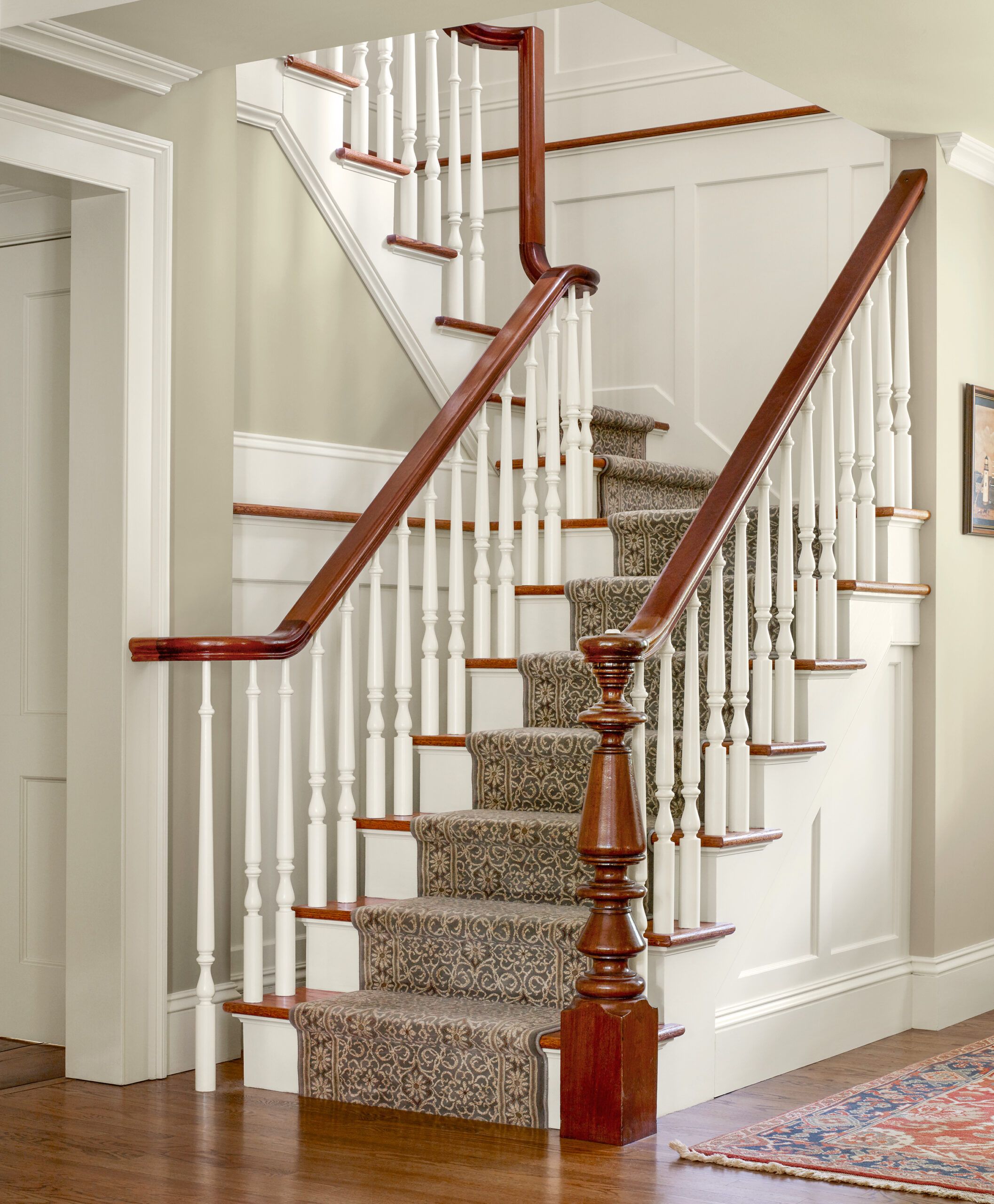
The paneled wainscoting, elegant handrail, and turned spindles on the back staircase could easily fool a visitor into thinking it is as old as the circa-1860 house.
Full Addition
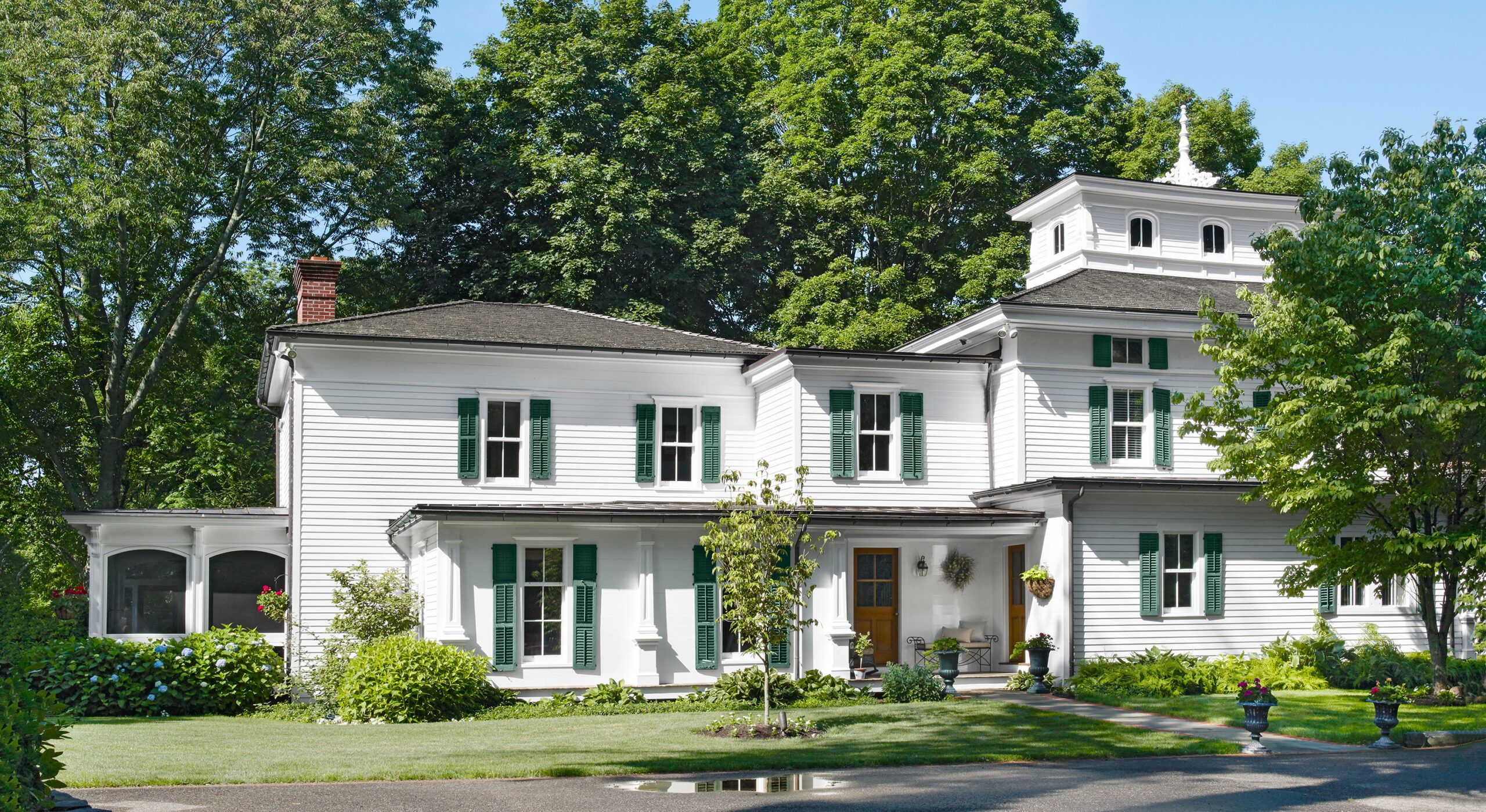
Seen from the side, the 2002 back addition closely mimics the style of the original mid-19th-century portion, but is stepped back and slightly smaller in scale.
Addition windows: Marvin Windows and Doors
Floor Plans
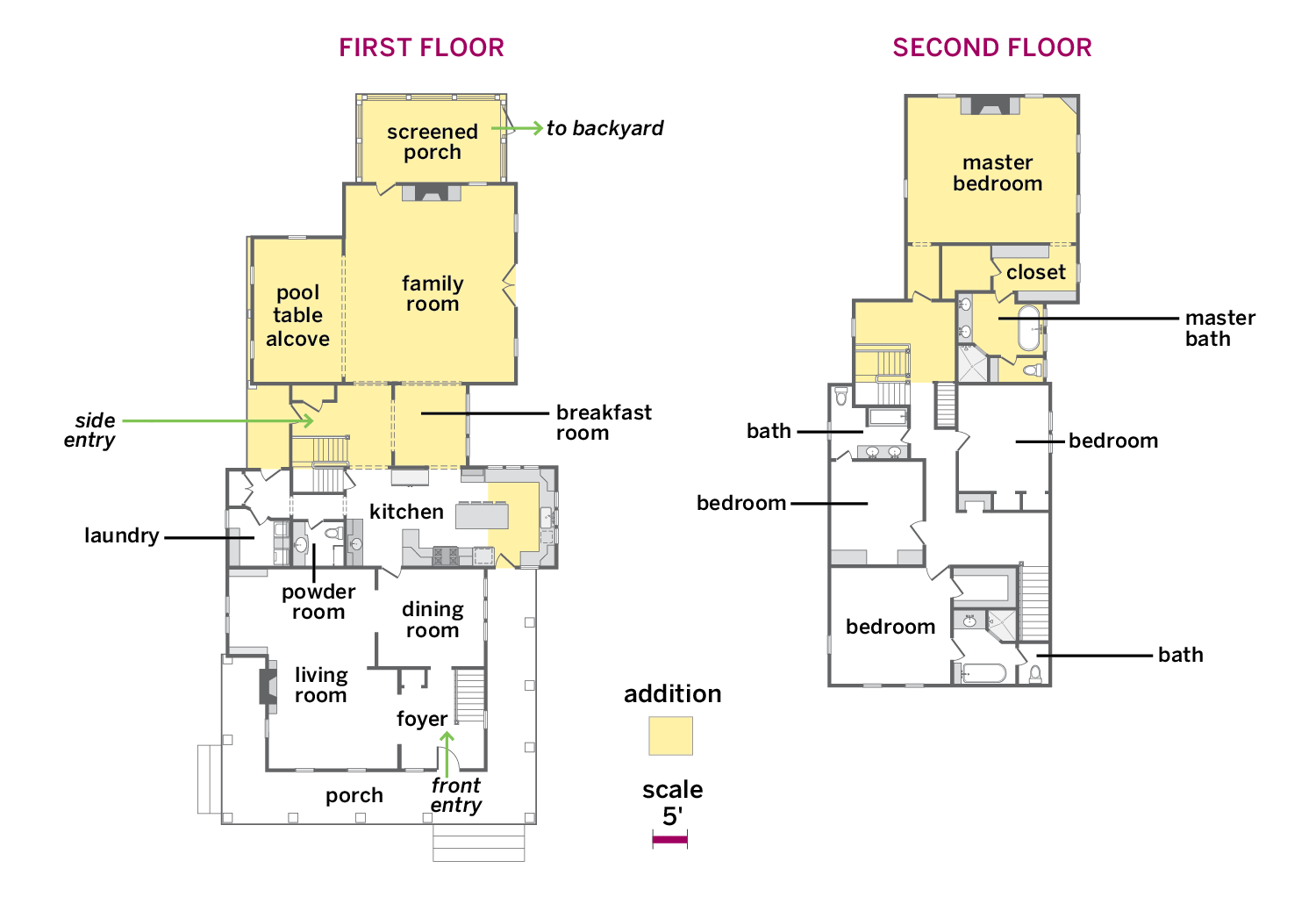
The layout in the original part of the house stayed largely the same; additions yielded 5,400 square feet of living space. The kitchen was bumped out, and a breakfast room, a family room with a pool table alcove, and a screened porch were added downstairs, with a master suite upstairs, for a total of four bedrooms and three and a half baths.
